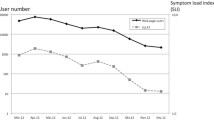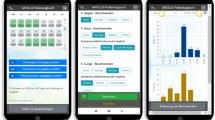Abstract
Hay fever is a pollen-induced allergic reaction that strongly affects the overall quality of life of many individuals. The disorder may vary in severity and symptoms depending on patient-specific factors such as genetic disposition, individual threshold of pollen concentration levels, medication, former immunotherapy, and others. Thus, information services that improve the quality of life of hay fever sufferers must address the needs of each individual separately. In this paper, we demonstrate the development of information services that offer personalized pollen-induced symptoms forecasts. The backbone of these services consists of data of allergic symptoms reported by the users of the Personal Hay Fever Diary system and pollen concentration levels (European Aeroallergen Network) in several sampling sites. Data were analyzed using computational intelligence methods, resulting in highly customizable forecasting models that offer personalized warnings to users of the Patient Hay Fever Diary system. The overall system performance for the pilot area (Vienna and Lower Austria) reached a correlation coefficient of r = 0.71 ± 0.17 (average ± standard deviation) in a sample of 219 users with major contribution to the Pollen Hay Fever Diary system and an overall performance of r = 0.66 ± 0.18 in a second sample of 393 users, with minor contribution to the system. These findings provide an example of combining data from different sources using advanced data engineering in order to develop innovative e-health services with the capacity to provide more direct and personalized information to allergic rhinitis sufferers.


Similar content being viewed by others
References
Aha DW, Kibler D, Albert MK (1991) Instance-based learning algorithms. Mach Learn 6:37–66
Aït-Khaled N, Pearce N, Anderson HR, Ellwood P, Montefort S, Shah J et al (2009) Global map of the prevalence of symptoms of rhinoconjunctivitis in children: the international study of asthma and allergies in childhood (ISAAC) phase three. Allergy 64:123–148
Arlot S, Celisse A (2010) A survey of cross-validation procedures for model selection. Stat Surv 4:40–79
Berger U, Jäger S, Bergmann KC (2011) PHD, the electronic patient’s hay fever diary. ERS congress. Eur Respiratory J 38:569, abstract 3213. http://www.ers-education.org. Accessed 27 November 2013
Berger U, Karatzas K, Jaeger S, Voukantsis D, Sofiev M, Brandt O, Zuberbier T, Bergmann KC (2013) Personalized pollen-related symptoms forecast information services for allergic rhinitis patients in Europe. Allergy 68:963–965
Blaiss MS (2003) Important aspects in management of allergic rhinitis: compliance, cost, and quality of life. Allergy Asthma Proc 24:231–238
Bousquet J, Van Cauwenberge P, Khaltaev N, Ait-Khaled N, Annesi-Maesano I, Baena-Cagnani C et al (2001) Allergic rhinitis and its impact on asthma. J Allergy Clin Immunol 108:147–334
Brandt O, Berger U, Karatzas K, Zuberbier T, Bergmann KC (2013) Electronic pollen diary: experiences gained with its application during the last three years in Germany. Allergo J 22:112–117
Breiman L (1996) Bagging predictors. Mach Learn 24:123–140
Demoly P, Bousquet J (2006) The relation between asthma and allergic rhinitis. Lancet 368:711–713
De Weger LA, Beerthuizen T, Hiemstra PS, Sont JK (2013) Development and validation of a five-day-ahead hay fever forecast for patients with grass-pollen-induced allergic rhinitis. Int J Biometeorol. doi:10.1007/s00484-013-0692-5
EAS QC Working Group (2011) Minimum requirements to manage aerobiological monitoring stations included in a national network involved in the EAN. IAA Newsletter December 2011, 72:1
EMEA (2008) Guideline on the clinical development of products for specific immunotherapy for the treatment of allergic diseases. Doc. Ref. CHMP/EWP/18504/2006. London
Ferguson BJ (2004) Influences of allergic rhinitis on sleep. Otolaryng Head Neck 130:617–629
Galán C, Cariñanos P, Alcázar P, Dominguez-Vilches E (2007) Spanish aerobiology network (REA) management and quality manual. University of Córdoba Publications Services
Hall M, Frank E, Holmes G, Pfahringer B, Reutemann P, Witten IH (2009) The WEKA data mining software: an update. SIGKDD Explor 11:10–18
Haykin S (1994) Neural networks: a comprehensive foundation. Prentice Hall, Upper Saddle River
Hirst JM (1952) An automatic volumetric spore trap. Ann Appl Biol 39:257–265
Huynen M, Menne B (2003) Phenology and human health: allergic disorders. Report of a WHO meeting, Rome, Italy, 16–17 January 2003. Health and global environmental change, Series No. 1. (EUR/03/5036791 and EUR/02/5036813)
Jäger S (2000) Ragweed (Ambrosia) sensitization rates correlate with the amount of inhaled airborne pollen. A 14-year study in Vienna, Austria. Aerobiologia 16:149–153
Karatzas K, Riga M, Smith M (2013a) Presentation and dissemination of pollen information. In: Sofiev M, Bergmann KC (eds) Allergenic pollen: a review of the production, release, distribution, and health impacts. Springer, New York, pp 217–247
Karatzas K, Voukantsis D, Jaeger S, Berger U, Smith M, Brandt O, Zuberbier T, Bergmann KC (2013b) The patient’s hay fever diary: three years of results from Germany. Aerobiologia. doi:10.1007/s10453-013-9303-5
Karppinen A, Kukkonen J, Elolähde T, Konttinen M, Koskentalo TA (2000) Modeling system for predicting urban air pollution: comparison of model predictions with the data of urban measurement network. Atmos Environ 34:3735–3743
Kmenta M, Bastl K, Jäger S, Berger U (2013) Development of personal pollen information: the next generation of pollen information and a step forward for hay fever sufferers. Int J Biometeorol, in press
Laatikainen T, von Hertzen L, Koskinen JP, Makela MJ, Jousilahti P, Kosunen TU et al (2011) Allergy gap between Finnish and Russian Karelia on increase. Allergy 66:886–892
Mandrioli P, Comtois P, Levizzani V (1998) Methods in aerobiology. Pitagora Editrice, Bologna
Quinlan JR (1992) Learning with continuous classes. In Proc 5th Australian Joint Conference on Artificial Intelligence (pp. 343–348). World Scientific Publishing Company Incorporated
Rodríguez-Rajo FJ, Astray G, Ferreiro-Lage JA, Aira MJ, Jato-Rodriguez MV, Mejuto JC (2010) Evaluation of atmospheric Poaceae pollen concentration using a neural network applied to a coastal Atlantic climate region. Neural Netw 23:419–425
Sanchez-Mesa JA, Galán C, Martinez-Heras JA, Hervas-Martinez C (2002) The use of a neural network to forecast daily grass pollen concentration in a Mediterranean region: the southern part of the Iberian Penisula. Clin Exp Allergy 32:1606–1612
Stone M (1974) Cross-validatory choice and assessment of statistical predictions. J R Stat Soc 36:111–147
Traidl-Hoffmann C, Jakob T, Behrendt H (2009) Determinants of allergenicity. J Allergy Clin Immunol 123:558–566
Voukantsis D, Niska H, Karatzas K, Riga M, Damialis A, Vokou D (2010) Forecasting daily pollen concentrations using data-driven modeling methods in Thessaloniki, Greece. Atmos Environ 44:5101–5111
Voukantsis D, Karatzas K, Kukkonen J, Räsänen T, Karppinen A, Kolehmainen M (2011) Intercomparison of air quality data using principal component analysis, and forecasting of PM10 and PM2.5 concentrations using artificial neural networks, in Thessaloniki and Helsinki. Sci Total Environ 409(7):1266–1276
Voukantsis D, Karatzas K, Jaeger S, Berger U, Smith M (2013) Analysis and forecasting of airborne pollen-induced symptoms with the aid of computational intelligence methods. Aerobiologia 16:149–53
Witten IH, Frank E, Hall MA (2011) Data mining practical machine learning tools and techniques, 3rd edn. Morgan Kaufmann, Burlington
Willmott CJ (1982) Some comments on the evaluation of model performance. Bull Am Meteorol Soc 63:1309–1313
Acknowledgments
This research has been partly founded by the Research Committee of Aristotle University of Thessaloniki through the “Excellence Fellowships for Postdoctoral Studies” program.
Author information
Authors and Affiliations
Corresponding author
Appendix A: algorithmic parameters
Appendix A: algorithmic parameters
MLP parameters
We evaluated network architectures consisting of one hidden layer, setting the number of neurons equal to n = (inputs + outputs)/2, where inputs is the number of input variables of the model and outputs is the number of output variables (in this case, outputs = 1). We used the Levenberg-Marquardt back-propagation algorithm during the training of the models, with a maximum number of epochs set to 500.
kNN parameters
We used the Euclidean distance as the metric of the kNN algorithm. The number of nearest neighbors used was k = 5, while the simple average was used to combine existing training examples.
M5P parameters
We set the minimum number of instances (M) per node at M = 4.
Rights and permissions
About this article
Cite this article
Voukantsis, D., Berger, U., Tzima, F. et al. Personalized symptoms forecasting for pollen-induced allergic rhinitis sufferers. Int J Biometeorol 59, 889–897 (2015). https://doi.org/10.1007/s00484-014-0905-6
Received:
Revised:
Accepted:
Published:
Issue Date:
DOI: https://doi.org/10.1007/s00484-014-0905-6




